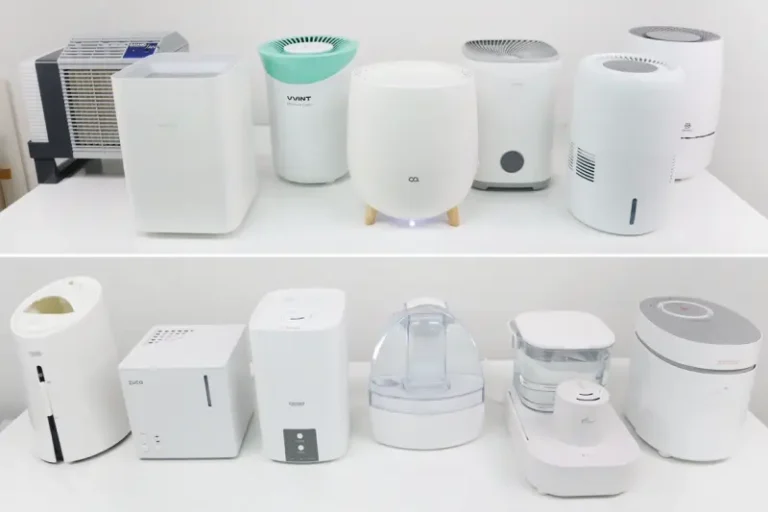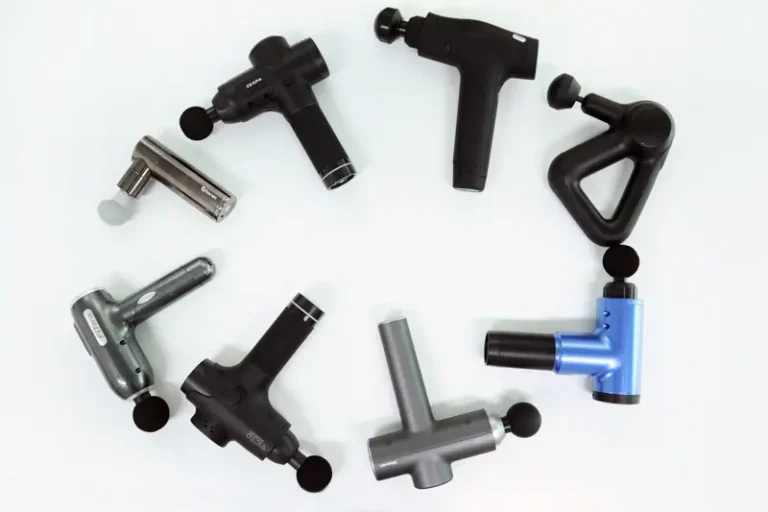The Best electric Shaver Buying Guide
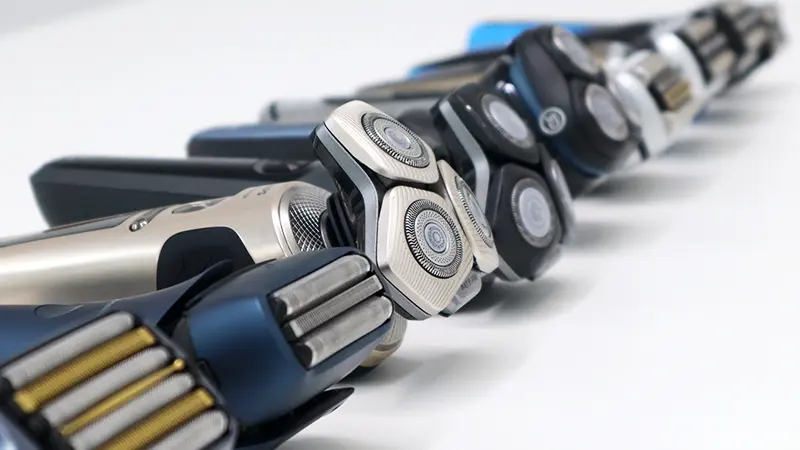
Electric Shaver Guide: High Price Doesn’t Mean High Quality!
Electric shavers are dominated by two major brands, Braun and Philips, with Panasonic coming in close behind. Together, these three brands cover most of the market share.
Electric shavers work by using a metal foil that covers the blades, which move in a reciprocating or rotating manner to cut facial hair. Unlike manual razors where the blade comes in direct contact with the skin for a close shave, electric shavers generally leave a bit of stubble. However, this design also means less skin irritation, making it a great option for those with sensitive skin.
Most electric shavers can be used both dry and wet, offering the flexibility to shave quickly and conveniently, even on busy mornings.
In this guide, we will compare the convenience of electric shavers with manual razors, explore the differences in shaving mechanisms, and help you figure out how to choose the electric shaver that best suits your needs.
Chapter 1.
Shaving Performance
Operation Method / Shaving Efficiency / Shaving Area / Skin Irritation
The shaving performance, area covered, and level of skin irritation of an electric shaver vary depending on its operational method.
A high-quality electric shaver should cut hair cleanly without pulling, provide a close shave, and cover a large area efficiently, allowing for a neat shave with fewer strokes.
We will compare the shaving performance of nine models from leading brands, evaluating each of these aspects based on hands-on use.
1. Electric Shaver Operation Method
Reciprocating Blade System: The blades move back and forth (left and right).
Rotary Blade System: The blades rotate in a circular motion.
The movement of the blades classifies electric shavers into two types: Reciprocating and Rotary.

Electric shavers work by having blades that move beneath a very thin metal sheet called a “foil,” which has small holes. The blades cut the facial hair that protrudes through these tiny holes.

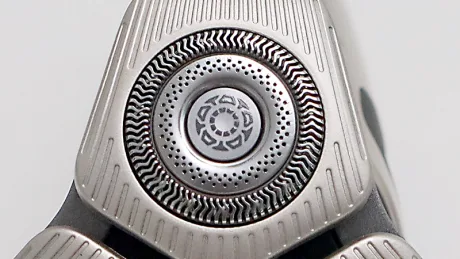

If the blades beneath the foil move side to side, the shaver is classified as Reciprocating; if the blades rotate, it is considered Rotary.
- Reciprocating Shavers lift and cut the hair in the opposite direction of hair growth, much like a traditional razor, making them easier to adapt to.
- Rotary Shavers require circular motions against the direction of hair growth, which may take more time to get used to.
Among the leading brands, Braun and Panasonic use the reciprocating mechanism, while Philips uses the rotary system.


In addition to the foil, there is also a comb-like blade called a trimmer, which lifts and cuts hair lying in different directions.
This component is unique to reciprocating shavers and is not found in rotary shavers.
2. Shaving Performance
The performance of a shaver varies based on its shaving method and brand, with differences in cutting efficiency, closeness of the shave, and the shaving surface area.
There is no significant difference in cutting efficiency.
Philips shavers provide the smoothest vibration experience.
When evaluating the performance of an electric shaver, key factors include cutting efficiency, closeness of shave, and shaving surface area.
A good shaving performance means the shaver effectively cuts hair, trims closely, and has a wide shaving surface to cleanly cover a large area in one stroke.

Cutting efficiency improves with the sharpness of the shaver’s blades and the speed of the shaver’s vibrations.
If the blades are not sharp enough or the vibration speed is insufficient, the shaver may struggle to cut hair effectively, causing a pulling sensation (especially with longer hair) and increased skin irritation.
Among the two foil shaver brands, Panasonic had faster vibration speeds and provided a smoother vibration feel on the skin.
The rotary shavers from Philips, unlike foil shavers, do not have noticeable vibrations, making the vibrations hardly felt when in contact with the skin.
Closeness of shave:
Panasonic > Braun > Philips

The design incorporates a suspension (spring) mechanism to ensure the blade stays in close contact.
Closeness of shave can be assessed based on two factors: the degree to which the foil adheres to the skin and the distance between the foil and the blade that cuts the hair.
Most recently released electric shavers have springs (suspension) beneath the blade or foil, allowing the blades to closely follow the contours of the skin. Therefore, the adherence of the foil to the skin does not significantly differ between brands.

The distance between the foil and the blade determines the remaining length of the beard.
On the other hand, a more critical factor in determining closeness—the distance between the foil and the blade, which influences the length of stubble left after shaving—showed noticeable differences.
After testing nine representative models across the lineups of the three brands, the difference was difficult to judge visually. However, a noticeable difference in closeness could be felt by running a hand over the shaved areas.

When comparing the length of the remaining stubble under a microscope, the results showed that the remaining hair length was as follows:
Philips > Braun > Panasonic, with Panasonic leaving the shortest stubble.
For the same shaving method and brand, a higher price does not necessarily mean a closer shave.


No noticeable difference to the naked eye.


After shaving, feeling the shaved area by hand, and observing the stubble under a microscope, the remaining hair length ranked as follows: Panasonic > Braun > Philips, indicating that Philips left noticeably more stubble.
However, the differences in cutting efficiency within the same brand and shaving method were minimal.
In essence, the shaving method itself is crucial; within the same method, an increase in blade count or additional features did not result in a significant difference in shaving performance.
Shaving Area (Head Size) Should Be a Key Consideration When the Beard Covers a Wide Area.

As the price of the shaver increases, the head size becomes larger and the number of blades increases.
However, a larger shaver head does not necessarily mean a proportionately larger shaving area. For example, Philips’ rotary shavers have a large head, but as shown in the picture, the actual shaving area is limited.

For oscillating shavers like Braun and Panasonic, the number of blades increases with the price, and the shaving area also proportionally expands.

Even with six blades, the range of the shaving blades that can reach under the philtrum is limited.
However, a larger shaving area is not always better.
Unlike Westerners, who often have softer beards covering a wide area, many East Asians have coarse beards concentrated in smaller areas like under the nose, philtrum, below the lips, and under the chin. Additionally, since the overall beard density is not very high, a larger shaving area does not significantly improve perceived shaving performance.
In fact, some users prefer electric shavers with a narrower head, which allows for precise targeting of specific areas, making them more convenient to use.

Philips shavers are inconvenient for focused shaving on narrow areas.
For Philips shavers with three rotating blades, when shaving small areas like under the lips or nose, only one of the three blades can be used at a time. This requires multiple passes over the area.
Even after multiple passes, some beard stubble often remains, extending the shaving time. As a result, the skin around localized areas like under the nose and lips may experience increased irritation.
3. Electric Shaver Skin Irritation
The degree of skin irritation varies by brand.
Skin irritation is inversely related to adhesion.
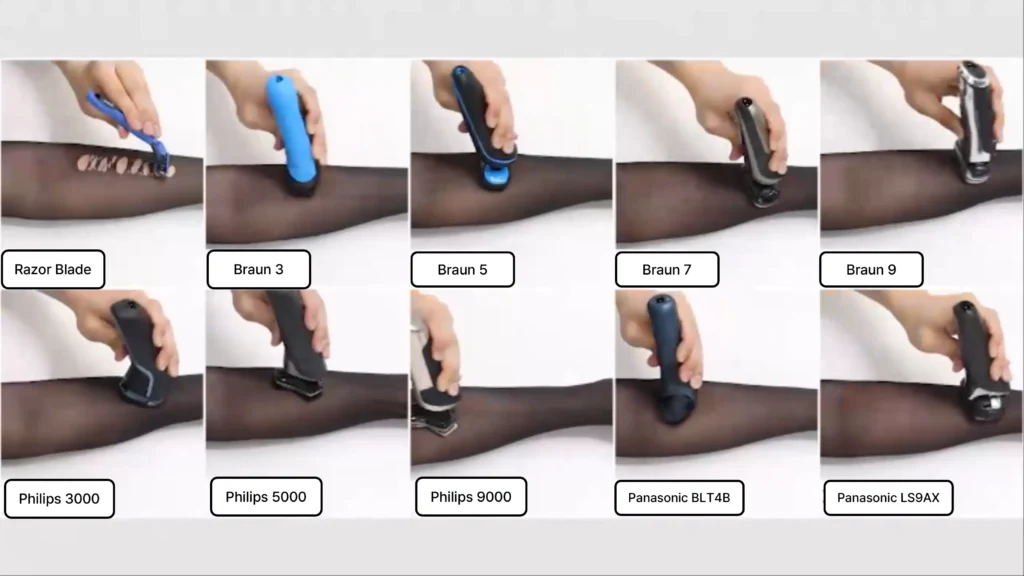
When rubbing stockings with both a manual razor and an electric razor, the stockings rubbed with the manual razor immediately developed snags, whereas those rubbed with the electric razor remained completely intact.
While electric razors are not as harsh as manual razors where the blade directly contacts the skin, they do still cause some skin irritation. Additionally, the perceived irritation differs slightly depending on the type of razor used.
To properly compare and highlight these subtle differences, we purchased nine different electric razors. Right after shaving, we rubbed the shaved areas with alcohol wipes to maximize any pain and then rated the level of pain to make a comparative analysis.

A higher score indicates a greater level of pain. Panasonic averaged 2.9 points, Braun 2.8 points, and Philips 2.1 points, with the two foil shaver brands (Panasonic and Braun) showing similar results, while Philips had a lower pain level.
Panasonic, which has a high level of adhesion, caused the most irritation, whereas Philips, which has a rotary design with lower adhesion, caused the least skin irritation.
※ For reference, the pain score for a manual razor is 3.2 points.
4. Summary of Pros and Cons by Brand

Panasonic offers better adhesion compared to Braun but tends to cause slightly more skin irritation.
Philips, with its rotary design, causes minimal skin irritation. Its operation is well-suited for shaving wide areas with hair growing in various directions, such as the cheeks, neck, or jawline.
Easy-to-adapt foil shavers (Braun/Panasonic)
Panasonic with the best adhesion
Philips with the least skin irritation
If you have a small area with thick facial hair, a foil shaver (like Braun or Panasonic) is recommended for its good adhesion and easy adaptability.
For areas with a limited hair growth area, there’s no need to purchase a model with a wide head. The actual shaving contact area is not significantly different, so the increase in price doesn’t necessarily enhance shaving performance.
Among foil shavers, if you prefer a closer shave and don’t mind slightly stronger skin irritation, Panasonic is a better choice over Braun.
For those with facial hair on curved areas like the jawline, neck, or throat, a rotary shaver like Philips is recommended. It provides superior shaving performance in areas where hair grows in multiple directions compared to foil shavers.
Philips is also an excellent option for those with sensitive skin looking for a shaver that causes minimal irritation. Among the electric shavers tested, Philips had the lowest level of skin irritation.
Chapter 2.
Electric Shaver Ease of Cleaning
Waterproof Performance / Blade Design / Cleaning Station
While you can easily choose a mouse based on its appearance and size, things get more confusing when you dive into specifications like DPI, sensor type, and response rate. Let’s break down the key terms often found on a mouse product page and understand which specs to focus on depending on your intended use.
1. Waterproof Performance
Most products are rated IPX7.
Be cautious with products intended for dry use only.

Most electric shavers released recently are suitable for both dry and wet use, offering waterproof performance rated at IPX7, which is sufficient for use during daily showers.
Even if waterproof performance is not explicitly stated, shavers that support wet shaving are generally water-resistant. Therefore, it is possible to disassemble the blade mesh and clean the blades under running water.

Some electric shavers are marked as suitable for dry shaving only on their product pages. If you prefer wet shaving or easy cleaning, it’s best to avoid these models.
2. Blade Mesh Structure
Integrated Type: Foil and blade are attached together
Separated Type: Foil and blade are detachable
Separated type offers easier cleaning.
The ease of cleaning can vary based on the blade mesh structure.
Shavers are categorized into integrated and separated types depending on whether the foil and blade are attached or detachable.
Integrated type with the blade and foil attached (Braun)

making it difficult to clean the gaps thoroughly.
The integrated blade mesh structure has a complex gap between the shaver’s blade and foil. Even after rinsing with water, tapping the shaver may still release a couple of leftover hair residues, making it difficult to clean the gaps thoroughly.
Separated type with detachable blade and foil (Panasonic)

In contrast, the separated blade mesh structure has detachable blades and foil, making it easier to clean as there are no complex gaps. This allows for a thorough cleaning with just water.
Braun products generally have an integrated structure, while some Panasonic models feature a separated blade mesh design.
Routine cleaning with water is simple, but complete disassembly is required for rotary shavers.

Rotary shavers, represented by Philips, are easy to rinse under running water. However, since the blade covers the foil, hair particles can become trapped in the gaps between the blades.
Therefore, it’s necessary to periodically disassemble the blade and foil to clean out the gaps. If not cleaned regularly, hair particles may remain stuck in the gaps.
In summary, among foil electric shavers, the separated design is more convenient for thoroughly cleaning hair particles, while the integrated type has limitations in fully cleaning the gaps.
Rotary shavers may trap hair particles in the gaps, but since the blade and foil can be separated, they can be thoroughly cleaned by disassembly.
3. Cleaning Station
Cleaning stations equipped with functions like charging, cleaning, and drying are typically included in mid- to high-end models.

For electric shavers priced over 100,000 KRW, you can use a cleaning station, which is a stand equipped with cleaning and charging systems. Depending on the product configuration, it may be included or purchased separately.
Each brand—Braun, Panasonic, and Philips—offers slightly different features in their cleaning stations.
Braun Cleaning Station

Braun’s cleaning stations are categorized into three types based on their features: charging, cleaning, and drying.
The 4-in-1 cleaning station, which has charging and cleaning functions only, is compatible with Series 5 to 7.
The 5-in-1 and 6-in-1 cleaning stations, which include drying functions, are compatible with Series 8 and 9.
The 4-in-1 station operates for about 2–3 minutes, while those with a drying mode run for around 10 minutes.

The noise level of the cleaning station increases in proportion to the shaver’s motor noise since it operates during the cleaning process.
Braun’s cleaning station has a noise level of 69–71 dB, making it the loudest among the three brands. However, the perceived noise is quieter compared to Panasonic


Braun’s cleaning station uses a cleaning fluid cartridge that fits into the station. However, a drawback is that it lacks a filter to trap hair particles, leaving them mixed in with the cleaning solution.
The recommended replacement cycle for the cleaning fluid is every 2 months, and each cartridge costs around 6,000 to 7,000 KRW
Panasonic Clean Station

Offers charging, cleaning, and air-drying modes. Unlike Braun, you can select either cleaning or drying mode separately.
With air-drying mode, it operates for about an hour.

While measuring 62-63dB, it subjectively feels the loudest among the three brands’ clean stations. The loud motor noise of Panasonic shavers results in louder clean station operation.
The motor only runs during initial cleaning (about 2 minutes), with no motor noise during air-drying mode, so don’t worry about continuous loud noise.

Panasonic’s cleaning solution comes in disposable shampoo-like pouches, diluted with water in the solution tank.

The clean station includes a filter to catch coarse beard residue, allowing more hygienic solution management.
While no official replacement cycle is stated, changing every 2 months is recommended, with solution packets costing about $3-3.70 each.
Philips Wireless Cleaning Pod


Philips’ cleaning pod operates wirelessly with cleaning function only.
Uses wireless cleaning solution cartridges with about 1-minute operation time.
Compatible with Series 7000 and 9000.

The cleaning pod has no power connection and uses the shaver’s motor, producing noise similar to normal operation – the quietest among three brands.

Post-cleaning foam might bother some users who’ll need to wait and rinse it off with water.
Philips solution comes in cartridge form with no stated replacement cycle. Costs about $6.70-7.45 per cartridge.
If Daily Shaver Cleaning Is Bothersome
Consider Products with Clean Station
Electric shavers require daily cleaning and sanitizing. For those concerned about skin irritation but finding cleaning tedious, products with cleaning stations are recommended.
However, Don’t Choose Products Based on Clean Station Performance

Choosing shavers based on clean station features isn’t advisable. While convenience varies slightly, cleaning performance remains similar.
Rather than clean station convenience, consider shaving performance, skin irritation, and water cleaning ease when selecting products.
Products with clean stations cost about $37-74 more, so consider whether to use the station or substitute with cleaning solution.
Tip: Using Shaver Cleaner Solution

You can sanitize electric shavers using commercially available cleaning solutions. These ethanol-containing solutions cost about $12.60-13.40 for three 500ml bottles.
Mix solution and water in a glass, submerge the shaver head and operate for 10-20 seconds, then rinse with water and shake dry.
This is an affordable and simple alternative when clean station costs are concerning.
Chapter 3.
Electric Shaver User Convenience
Maintenance Cost / Charging Convenience / Trimmer / Other Features
1. Maintenance Cost
Electric shaver maintenance cost = Blade mesh cost
Blade mesh prices vary widely
Braun’s blade replacement cycle is 18 months. Since Braun uses an all-in-one blade system, you can replace everything at once. Philips recommends replacement every 24 months.
For Panasonic models with separate foil and blade components, each part needs individual replacement: the foil every 12 months and the blade every 24 months. Panasonic’s all-in-one models have an 18-month blade replacement cycle.

Please refer to the above table for blade mesh prices.
Tip: Blade Mesh Upgrade?

Braun Blade Replacement

Philips Blade Replacement
While manufacturers don’t officially confirm compatibility:
We’ve verified that Braun Series 5 and 7 blade meshes are interchangeable.
Similarly, Philips’ SH71/51 blade mesh for mid-range 5000/7000 series and SH91/51 for 9000 series look similar and are interchangeable.
When it’s time to replace, you might upgrade performance by using a higher-tier model’s blade mesh.
2. Charging Convenience
All three major brands use proprietary ports
Most fully charge in an hour
Charging convenience is similar across brands
Electric shavers need charging for cordless use.
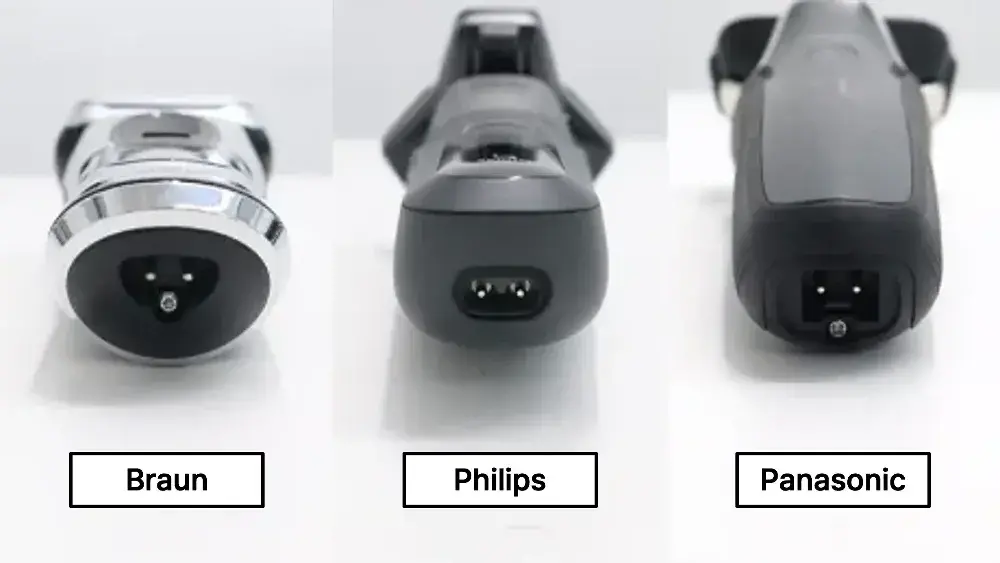
Braun, Philips, and Panasonic each use their own proprietary ports, incompatible with other brands. Most electric shavers take about an hour to charge and operate for 30-60 minutes.

Philips’ premium Prestige 9000 series only supports wireless charging, with a longer 3-hour charging time.

Some products include charging stands for upright charging.
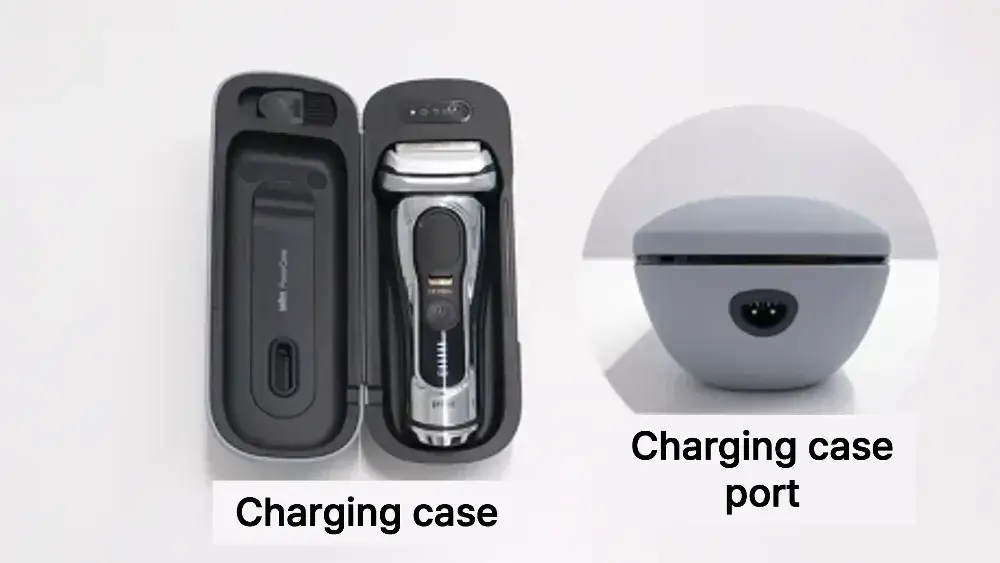
Some Braun 9 PRO premium models include battery-equipped charging cases, convenient for travel without separate chargers. However, it’s disappointing that even the charging case requires a proprietary charger.
Tip: Blade Mesh Upgrade?
Battery level indicators vary: LED color indicators, 3-5 level gauges, or percentage displays, with percentage displays being more expensive.
3. Electric Shaver Trimmer
Trimmer for long hair grooming
Easy sideburn and beard line trimming
Avoid replaceable type if frequent use needed
Electric shavers are designed for short beards, with foils not effectively catching long beards. In such cases, use a trimmer to shorten beard length before shaving.
Trimmers also help maintain sideburns and beard lines. They’re particularly convenient for neat sideburn trimming – some users find it difficult to use shavers without trimmers once accustomed to them.

Trimmers come in three types: replaceable head type, slide-up type, and pop-up button type.
If you’ll use the trimmer frequently, avoid the replaceable type.
4. Additional Features
Travel lock mode / Shaving mode settings
Beard grooming attachments optional

Travel lock mode prevents accidental operation when buttons are pressed in luggage or bags. Usually activated by holding the power button.
Some Braun and Philips models offer adjustable rotation speeds, called Soft Mode or Turbo Mode. However, most users operate at maximum mode, making this feature somewhat unnecessary.

For those growing beards while using electric shavers, some models include beard combs for length adjustment. Additional accessories may include facial cleansing heads and grooming heads – choose based on your needs.


